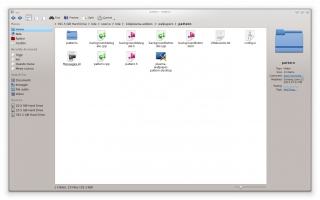Dolphin
 |
Filmanageren med de skjulte talenter |
Hovedpunkter
- Enkel at bruge, dedikeret til håndtering af filer
- Fokus på arbejdsgange
- Brødkrumme navigations linje
- Valgfrie paneler til bekvem navigation og informationsvisning
- Håndtering af netværks- og pseudo-filsystemer via KIO
- Du kan mærke filer og mapper og søge efter filer med et givet indhold ved hjælp af Nepomuk
Ved første blik ligner Dolphin en enkel fil manager, men den har mange talenter. Den kan blandt andet:
- dele vinduer - se og arbejd med to mapper samtidigt;
- sætte (og huske) visningsindstillinger uafhængigt for hvert vindue;
- arbejde i faneblade;
- vise det valgfri informationspanel på højre side,
- eller vise essentielle informationer i vinduet;
- bruge 'brødkrummer' til hurtig navigering;
- skifte til en redigerbar navigationslinje med et klik;
- tilføje et mappepanel til traditionel navigering;
- tilføje en terminal i den mappe du gennemser;
- kontrollere mange funktioner ved hjælp af tastaturgenveje.
Vejledninger
Filosofi
Dolphin is a file manager focusing on usability. When reading the term Usability people often assume that the focus is on newbies and only basic features are offered. This assumption is wrong.
Target User Group
Focusing on usability means that features are discoverable and efficient to use. The feature set is defined indirectly by the target user group of Dolphin:
- Lisa: Lisa is familiar with computers since 10 years. Due to her job she has experience with Word, Excel and Outlook. At home she mainly uses the computer for browsing the web and writing e-mails. She requires a file manager for managing photos from the camera, documents she gets per e-mail or PDF-documents she downloads with a browser. Lisa knows concepts like folders and a file hierarchy, but she is not familiar with the file hierarchy of Linux.
- Simon: Simon has been a developer at a software company for 8 years. At home he uses a file manager to maintain his large collection of photos and music. Additionally he owns a small homepage and needs to transfer updated files on the FTP server. Moving and copying files are regular tasks in Simon's workflow.
Not part of the target user group of Dolphin are Fred and Jeff:
- Fred: Fred is 75 years old and is able to write e-mails and browsing the web. He is not familiar with file hierarchies and stores all his documents on the desktop.
- Jeff: Jeff is Linux-freak since the age of 16 a few years ago. He is developer and in his spare time he acts as administrator for a small company. Jeff has two monitors to keep the overview about his huge number of opened applications.
This does not mean that Fred or Jeff cannot work with Dolphin. But there might be features and concepts of Dolphin that overburden Fred. Also Jeff might miss some features which are a must-have for his daily work.
Non-Intrusive Features
Before a feature is added in Dolphin, it is checked whether the feature is mandatory for the target user group. If this is not the case, then this does not mean that the feature cannot be added; first it must be clarified whether the feature might be non-intrusive, so that it adds value for users outside the primary target user group of Dolphin. Non-intrusive is mainly related to the user interface. A feature that adds a lot of clutter to the main menu, context menus or toolbar might harm the target user group. In this case the feature will not be added.
A good example of a feature that is non-intrusive is the embedded terminal in Dolphin. It only requires one entry inside a sub menu, but adds great value for Jeff, who is not part of the target user group.
Options
Options are mandatory as the user "average Joe" does not exist. Still it is not the goal of Dolphin offering options for all kind of things. Again the focus is on the possible needs of the target user group. Each additional option makes it harder finding other options, so the same rules for features are applied to options too.
- Brug 'brødkrummerne' for hurtig navigation
- Skift til redigerbar navigationslinje med et enkelt klik
- Tilføj panelet Mapper til traditionel navigering
- Tilføj en terminal i den mappe, som du arbejder med
- Mange funktioner kan kontrolleres ved hjælp at tastaturgenveje
Problem: Dolphins menupunkter eller har ingen valgmuligheder. Nepomuk er aktiveret i Systemindstillinger.
- Løsning: Omdøb mappen ~/.kde4/share/apps/dolphin (i nogle distro'er hedder mappen ~/.kde/share/apps/dolphin) og genstart Dolphin. Dette vil fjerne alle dine tilpasninger af Dolphin, men valgmulighederne skulle komme tilbage. Hvis alt virker som det skal, så kan du slette mappen. Dette skete for mig efter opgradering fra KDE 4.4 til 4.5
Problem: Når jeg vælger et program til at åbne et given filtype med, så påvirker det tilsyneladende også andre filtyper. Det er som Dolphin ikke kan se forskel på de to forskellige filtyper.
- Løsning: Sandsynligvis kender KDE-platformen ikke til den ene af filtyperne, så den associerer den ukendte filtype til en anden, kendt filtype. Dette forekommer ofte med XML-baserede filtyper; hvis filtypen ikke er kendt af KDE-pltformen, så vil de blive behandlet som alle andre XML-filer og blive åbnet med standardprogrammet til at åbne XML-filer, selv om de har deres egen filendelse (fx .xliff eller grapgml)
- For at løse dette problem kan du bruge Fileassociationer til at oprette et punkt for en ukendt filtype.
Se også forumerne, Dolphins websted og Dolphin-håndbogen.
Nøgleord
fil management, fil manager, fil browser, tags, metadata, Nepomuk
